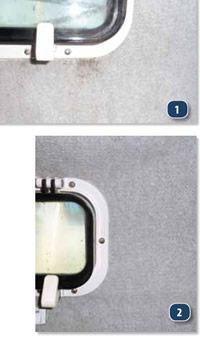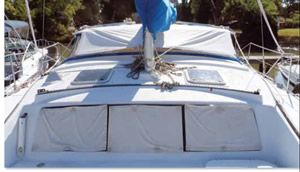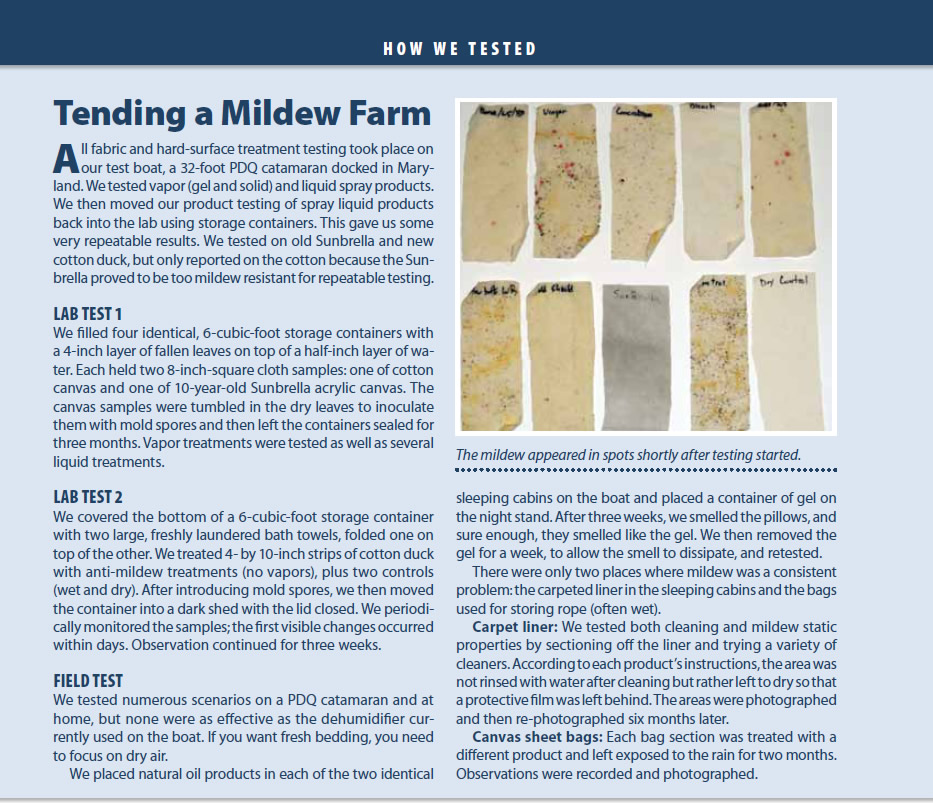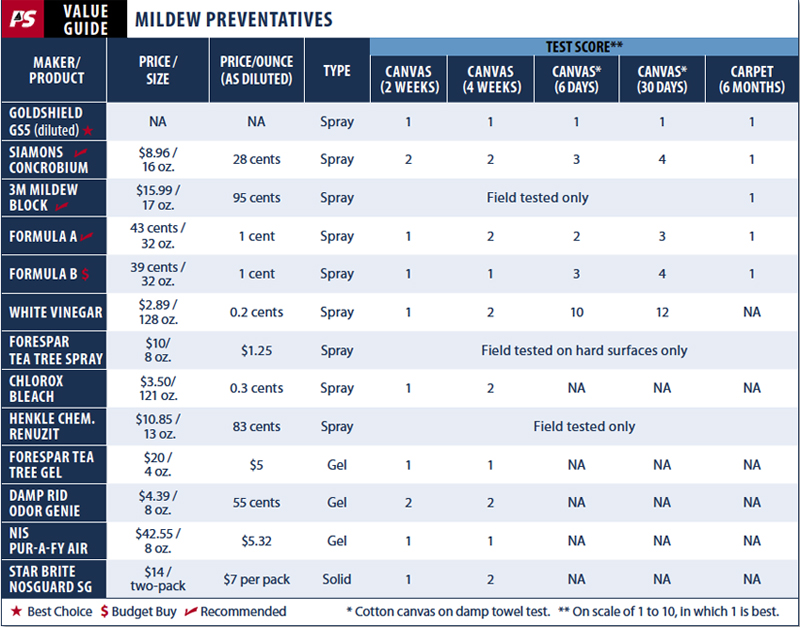
Black spots and boat smell are just as much a part of sailing as bottom painting and folding sails-unpleasant bits we wish would go away but accept as a part of the game. Four years ago, we tested a cross-section of commercial mold-cleaning products (PS, January 2009). The next year, we tested a group of mold-inhibiting products (PS, June 2010). This test builds on those reports to offer a reliable way to keep your boat cabin as fresh-smelling as home. This is not as easy as it sounds.
We recognize that no chemistry in a bottle is going to keep a damp boat fresh. Desiccants can help, and dehumidifiers (PS, June 2013) are a surefire defense, but these arent always practical. Thus, we went back to the bottle to see what might help.

What We Tested
The 13-product test field comprised liquid-sprays, and gels and solids that work through emitting a vapor. The three vapor products were Star brites NosGUARD SG, which reacts with water to release chlorine-dioxide gas; Forespar Tea Tree Power, a tea tree oil-based gel in a vented tub; and Pur-A-Fy Air from Natures Innovative Solutions, a lemongrass oil-based gel.
The liquid-spray group included Forespars Tea Tree Oil Spray, Henkle Chemicals Renuzit, Siamons Concrobium, Goldshield GS 5 (diluted to the equivalent of GS 75), and 3Ms Marine Mildew Block, which did well in our June 2010 test. Concrobium is available in liquid and vapor form; we tested the liquid. Goldshield surface anti-microbial is a new generation microbiostat patented by Emory University.
We also tried two homemade spray formulas. Testers concocted Formula A to mimic the formula found in Concrobium. Formula A combined one quart hot water, one tablespoon baking soda (sodium bicarbonate), two tablespoons washing soda (sodium carbonate), and two tablespoons trisodium phosphate (TSP). Formula B combined one quart hot water, two tablespoons baking soda, two tablespoons Borax, and one tablespoon TSP. We also tried plain vinegar, which reportedly works on some hard surfaces. Like other treatments, the vinegar must be left to dry in order to work. A 10-percent solution of household bleach (3-percent sodium hypochlorite) rounded out our test group.
Natural oils are classified as vapor biostats, and to work, the vapors need to be delivered in a concentration where new growth is slowed. Based on our calculations, the tea tree oil formula would be more effective than the lemongrass. Star brites chlorine-dioxide NosGUARD SG is only a shock treatment and will not provide ongoing protection.
Natural products have risks, too. Tea tree oil has appreciable acute toxicity (about eight times greater than ethylene glycol antifreeze) and can cause allergic reactions. There is also concern in some circles about encouraging the development of new antibiotic-resistant strains.
The quaternary ammonium, broad-spectrum disinfectant we tested, Goldshield, is also formulated to prevent the emergence of resistant organisms. After this test was started, we learned of other quaternary ammonium products, such as Elite Marine Shield, which sells a concentrated broad-spectrum microbiostat from Priogienics. We will be testing it in the future.
Our liquid-spray products came in two types. Inorganic alkaline mildew preventatives like Concrobium and 3M Mildew Block leave an alkaline polymer film that prevents spores from growing. These products are typically sprayed on, scrubbed as needed, and left to dry. They carry no risk of promoting anti-biotic resistant organisms. The second liquid-spray type combined Borax (sodium tetraborate), which has natural anti-bacterial and anti-mildew properties, with an alkaline film.
Widely marketed under the 20 Mule Team label, Borax has been used as a laundry aid for many years. Insects don’t like Borax either. Though we wouldnt promote Borax as a food additive (still done in some countries), a few grams in a cleaner seems safe. It does not bio-accumulate, and its low toxicity makes it one of the most common pesticides used in kitchen areas. Still, anyone concerned about toxicity should research these safe products, which are registered with the Environmental Protection Agency (www.epa.gov) as pesticides, fungicides, or herbicides.
Observations
We conducted two lab tests and one field test (see How We Tested). In the lab tests, we saw mixed results. The Sunbrella samples remained mildew free. All of the samples developed a few small mildew spots, but not enough variation for us to find a favorite. While theory suggests that all of the vapor products should be effective in closed spaces, don’t expect miracles where large amounts of porous material can absorb natural oils or neutralize vapors.
In our field tests, it was apparent that certain products were working and others were not. The vinegar sample quickly became more infected than the control. Our spores apparently had a taste for vinegar. While anecdotal experiences suggest vinegar works on hard surfaces, we do not recommend it for upholstery.
The alkaline treatments were all similar in effectiveness, although our homemade Formula B with Borax performed best. Bleach did remarkably well, showing complete resistance to reinfection, probably because of some residual alkalinity. Of course, the sample was bleached, reminding us that bleach is only suitable for completely color-fast surfaces and materials. And as we learned during our rope-cleaning test, bleach can significantly degrade fibers. The real standout was Marine Shield, which remained very nearly indistinguishable from the control in this truly demanding test.
Since lab testing had convinced us that the natural vapor products could not prevent tough infestations, we evaluated their ability to keep bedding and automobile interiors fresh-scented. We found that the pillows and interiors were noticeably fresher after a few weeks of exposure. The freshness persisted only for a few weeks, so continuous treatment is needed. To us, these products seemed mostly to be masking odors. None were nearly as effective as simply running a dehumidifier. We believe these products can retard mildew growth, and the science supports that; its not enough to make a difference in any area where infestation is significant.
All of the spray products gave similar coverage, as all are water-based and have the same instructions: Spray from 6 to 10 inches away until the fabric is moist, remove excess, and let sit. Figure on about 100 square feet per quart, and at least double that figure on hard surfaces. The Forespar tea tree spray goes further due to a highly concentrated fragrance.
All of the liquid formulas kept the carpeted cabin-liner clean. While some mildew returned to the control area, the treated areas stayed clean and fresh-smelling for six months. Also, all of the products proved to be effective carpet cleaners, although not as effective as heavy-duty carpet cleaning compounds.
Perhaps the toughest test we could concoct (high moisture, rain exposure, cotton duck, dirt from deck run-off) was our bag of wet sheets. The rain simply washed out all of the treatments, including Goldshield, which claimed to be highly resistant to moisture. Perhaps the suns UV destroyed the organic active ingredients. In the cockpit, the best prevention is using mildew-resistant materials and self-draining lockers.
We werent impressed with any of the products as hull or deck cleaners. They seemed to deteriorate or wash away in the weather and can strip away wax. However, one tester found the home-made Borax formula (Formula B) to be reasonably effective as a teak cleaner, particularly when he doubled the dosage. (Only do this for wood cleaning.) We were pleased with the way this formula prevented mildew on the exterior wood flooring under the hard dodger. We have also been testing Borax/glycol mixtures for in-ground wood preservation and have been very pleased-something wooden boat owners might want to experiment with.
Star Brite NosGUARD SG
When exposed to water (either in a sponge or moisture in the air), Star brites NosGUARD undergoes a chemical reaction and releases chlorine-dioxide gas. To our knowledge, these were first introduced to the used-car trade as a way of killing foul odors that often permeate used cars. Similar to bleach in gas form, chlorine dioxide can penetrate carpets and upholstery, killing microbes and smells wherever it can reach. There is a warning on the container to keep the unit 18 inches from bleachable surfaces. It is also better if you leave the boat when its activated. NosGUARD is intended to be left in a sealed car overnight. While this product removed surface odors in our test, it could not overcome heavy mildew nor provide long-term protection.
Bottom line: Rather than relying on NosGUARD, the owner of a used boat is going to be happier if he bites the bullet and cleans the boat thoroughly and then concentrates on keeping humidity levels down.
Forespar Tea Tree Power Gel
Most testers liked the scent of Forespars tea tree oil gel (10 percent tea tree oil), which is delivered in a vented tub. However, after extended testing in boats and cars, we decided that it did nothing for healthy mold colonies.
The chemistry suggests it should help reduce new growth in marginal cases, but our testing was not designed to show this. A tub will last four to 16 weeks, depending on temperature and humidity. The 8-ounce size is recommended for 30- to 40-foot boats. It is also available in an 8-ounce spray (7-percent tea tree oil).
Bottom line: We think it is fine for freshening cabins, but don’t expect miracles.
Pur-A-Fy Air
The Pur-A-Fy Air from Natures Innovative Solutions works like the tea tree oil gel, but it uses lemongrass oil, which also has proven antibacterial properties. Like the tea tree oil blend, Pur-A-Fy Air could not kill or inhibit mold in damp, heavily contaminated environments. It prevented musty smells from returning, although the tea tree oil seemed to have an edge.
Testers generally preferred this scent over the tea tree oil. A tub will last four to 16 weeks, depending on temperature and humidity. The formula is not cheap, $43 for an 8-ounce tub.
Bottom line: Pur-A-Fy Air is an expensive air-freshener that has some limited natural mildew-fighting properties and a nice scent.
Forespar Tea Tree Oil Spray
We tested the Forespar tea tree spray in places that were damp and smelled but that we couldnt reach for cleaning (sun roof, space between liner and hull). We found the fragrance strong but not unpleasant. A little spray goes a long way. The fragrance dissipated quickly from hard surfaces, but for porous surfaces and upholstery, be careful to apply only very lightly.
The Forespar tea tree spray didnt eliminate odors in a few dark corners where bleach worked just fine, suggesting that these natural oils are of limited effectiveness. While this product can form part of an odor-control strategy, we don’t suggest it for the heavy lifting. There are better products for killing and cleaning.
Bottom line: Use sparingly for masking odors and perhaps to control some incipient mildew.
Renuzit Super Odor Neutralizer
Testers have a lot of experience with Renuzit Super Odor Neutralizer from Henkle Chemical, having used it with flood-damaged carpet and musty boats. It does not claim to prevent mildew reinfection, but it suppresses odors without a strong masking scent, if the infection has been killed by other chemistry. We did not test its ability to inhibit the growth of mildew; we only used it as a comparison for the masking effect of other products. It worked as well as any at a similar price point.
Bottom line: While it wont kill mold, our test noses approved, and it certainly could make sense as part of a spring cleanup.
Siamons Concrobium
The best performer in prior Practical Sailor testing, Concrobium removed the mildew from the test carpet section and did not allow it to return, even though the area did get damp again. It also did very well in the cotton duck testing.
Bottom line: This Recommended product rated well again, but it was matched by the cheaper, homemade Formula A.
Goldshield GS 5
Goldshield GS 5 (diluted to GS 75) was the clear winner in our on-deck testing and in our moist-environment testing. While the control turned multicolored within days and other treated samples spotted within weeks, Goldshield stopped mildew cold. Some of this might have been due to its superior water resistance in the moist environment test, but thats realistic enough in a marine environment.
To use, you spray-apply it until the article is moist and then allow it to dry. Originally designed for hospital use, Goldshield comes with a string of health warnings, but properly applied, it should be safe for onboard use.
In addition to its usefulness as a fabric and hard-surface mildew preventative, it is also listed for use as a paint additive, foam additive, and about every other application we could imagine.
The literature suggests reapplication every three to five months, depending on exposure. In the field we tested it for six months on a carpeted headliner that had previously mildewed. It did not provide long-term protection for our sheet bag.
Bottom line: This product was a clear winner, earning the Best Choice pick. It is currently available only on the web (see link this page) but the company is working on a wider distribution for the marine market.
3M Marine Mildew Block
In prior testing (PS, June 2010), 3Ms Marine Mildew Block performed fairly well, finishing just behind Concrobium, and in our boat cabin test, it did well again. We did not test it in the wet towel chamber.
Bottom line: Based on the formula, we expect that the water resistance will be superior to Concrobium and the DIY blends. This is good product for areas exposed to occasional spray.
Formula A
Much like Concrobium (which it is modeled after), our homemade Formula A removed the mildew from the test carpet section and kept it away, even though the area got wet again. It was also very effective in the moist environment test.
Bottom line: This homebrew is cheap. It works. Find your own empty spray bottle and try it. Its Recommended.
Formula B
Testers homemade Formula B was the second-place performer in the liquid group. It was certainly the best value. It cleaned well, prevented reinfection of the carpet, and greatly slowed infection in the moist environment test.
We have also been testing Borax formulations for wood rot prevention, where they are doing very well.
Bottom line: Without a doubt, this was the cheapest mildew solution. It gets the Budget Buy pick.
Bleach
We tested a simple 10-percent solution of household bleach (3 percent sodium hypochlorite) in the moist environment test. While many predicted it would not kill the mildew and that the surface would quickly re-infect, that isn’t what happened. Because we did not rinse, perhaps there was enough alkaline residue to prevent mildew from returning. Obviously, it cannot be used on materials that will be discolored, and we are concerned about long-term physical damage to fabrics because long-term protection required not rinsing. There are short-term exposure hazards and unpleasantness involved in its use, particularly in tight places.
Bottom line: Bleach killed mold, removed stains, and greatly reduced reinfection. Bleach is not eco-friendly (it is strongly discouraged for on-the-water cleaning), but it still has a place in the cleanup arsenal.

Conclusion
Silicone quaternary ammonium salts like Goldshield clearly have an edge in the battle against mildew. These products are effective at lower doses than the alkaline treatments, and after drying, they offer significantly better water resistance than the simpler alkaline treatments. They are typically broad-spectrum biostats and in many cases are registered with the Environmental Protection Agency as such. They are regarded as safe when used as directed and are approved for a very wide range of applications.
Bleach will degrade these biostats, so they should not be applied to surfaces cleaned with bleach unless they have been well rinsed and the residual chlorine smell is gone.
Although it didnt last long on deck, Goldshield protected every material tested in the dampest of environments where untreated items developed mildew.
The spray-applied alkaline and Borax-based products were effective in the cabin or in any area protected from flowing water or rain; condensation did not seem to reduce their effectiveness. Bleach was remarkably effective when we did not rinse with fresh water, but sailors should be aware of bleachs bad reputation in the marine environment.
We liked the homebrews for their low price, and also because we prefer knowing just whats in a formulation. We like to know there is nothing present that is significantly hazardous to our health, the environment, or the materials of the boat.
Natural oils? We couldnt demonstrate their ability to kill significant infestations or prevent mildew in challenging conditions, but they seemed to help, and the science supports that result. If you like a particular scent (and there are many), this approach could be a part of your fresh boat strategy.
However, dehumidification or ventilation-keeping things dry-was far more effective than any product we have tested. Dry should always be the first line of defense, with chemical treatments saved for those few spots that unavoidably get damp from time to time.






































Good morning & thank you for the information… also I have a question… I’m buying a 1999 cruisers yacht 3075 with stern drives… & having it delivered to my office… I would like to do some repairs & upgrades to it before taking it to the lake & slip… so upon receiving the boat can you tell me the types of stands & how many to place it on for about 4 months before it goes to the lake… thank you very much
In recent winters I’ve left the overhead hatches open under the cover. When I make periodic checks on the boat I run all the fans while enjoying a beverage that’s resistant to freezing. I always had to scrub away mildew in the Spring before, hardly at all recently. Obviously, you need to trust your cover.
Good article, as a professional textile cleaner I would add 35% hydrogen peroxide h2O2 to my solution as it’s a nontoxic bleach that returns to water. Safe for you and environment. I have found that it with a simple green formula works well for cleaning.
Mildew is a huge problem in Tampa Bay, where the air is often still and dirty. I’m fighting it with a little dehumidifier inside and keeping much of the boat covered and out of the sun and rain. I think mildew likes the sun. Don’t green things grow in the sun? I’ve settled on scrubbing with equal parts vinegar, Simple Green and water, but then rubber and Lexan aren’t on my deck for vinegar to damage. Mildew isn’t the worst of it. There’s mold in the teak on deck, for which there is no cure. Since mold doesn’t really harm wood, I’ve been sealing it with epoxy and then painting it, hoping the mold won’t shine through eventually. So far so good.
For Dan: So I could mix 35% hydrogen peroxide with Simple Green and water to clean and it wouldn’t bleach my paint or harm anything?
You didn’t test Lysol products? I have great experience using Lysol spray and the concentrated Lysol soap in a pressure washer to reach spaces on my boat that I can’t see or reach with my hands.
Here’s my previous post on this topic that mentions Lysol. https://www.practical-sailor.com/blog/tips-on-preventing-mildew-growth-on-boats-and-sails
We’ve tested it at some point, I’m sure, but can add it again for any follow ups. If you search “mildew,” on the website, you’ll find a ton of information on this topic. Basically, if you haven’t tried Formula A or B yet (see recipe above), we recommend trying those first. We think you’ll be surprised at the results. AS the article states: “We liked these homebrews for their low price, and also because we prefer knowing just whats in a formulation. We like to know there is nothing present that is significantly hazardous to our health, the environment, or the materials of the boat.” The attached link also addresses an important element — good ventilation, and low humidity below decks. Our December 2020 issue looks at removing Dry Suit stink adds another perspective to our anti-mildew library.
For a non-marine use,,,
We’ve used the Formula A to be really good for treating mold/mildew on the rafters in our home’s attic prior to remodeling. (adding proper venting and insulation). Just wondering though, we cannot obtain “real” TSP around here anymore. Do you think the TSP Substitute sold now product is any good in this formula?
Hi there, Very informative post, thank you for taking the time to write this all out!
Is there a formula that is safe for marine life and easy to use? Again thanks! 🙂
My CSY 44 has basically 3 cabins; a completely separated aft cabin, the v-berth and the main cabin connected to the V-berth. I have intake and exhaust solar vents in all cabins as well as electric fans I run when not on the boat. I wipe down in the spring with a chlorox/water solution and spray either Lysol or equivalent solution before leaving the boat on the overhead. No mildew problem in my 30 years of ownership.
Very helpful Article and Evaluations!
If the mildew is growing on interior woodwork lemon oil is terrific. Kills it, keeps it from growing back for months, and replaces that sour smell with a pleasant scent. It’s even good for the wood. I’ve been using it for years.
For hard surfaces I use a two step process. White Vinegar followed by Baking Soda and water. Spray the vinegar (straight from the bottle) on rub lightly with a soft brush or sponge. Follow by Baking Soda dissolved in warm water (a couple heaping table spoons with 2-3 or so cups warm water) with a sponge. You may want to go over it with water to get any baking soda grit off. The change in pH will kill most mildew, and it smells fresh.
P.S. I use this on my raw teak table too, but rinse with fresh water.
Excellent advice by PS on how to keep ahead of mildew on your boat.
I live in a very humid environment Bermuda. I love your articles and have used many of your suggestions solutions to maintaining our boats.
I have found a product that works wonders on mold! It’s called X14 and sold as a bathroom cleaner. It is great on canvas, vinyl, cloth and hard surfaces, no scrubbing!
We have used tree tree oil/gel for our boats when stored in FL and GA. We typically place about 10 tubs around the boat (catamarans) and always make sure no drawers or lockers are closed. It costs us about $200 every three months for the gel. Nice smell! Where can I find the formulation for “Formula A”?
We use clove oil mixed with detergent and water. It removes mould and hasn’t come back so far. We are in the high tropics of Australia.?
Dear Author,
Your article on mildew focuses primarily on fabrics. In my experience removing the moisture inside the boat with moisture absorber on a weekly basis has been the most effective means of eliminating mildew below decks.
My concern is with vinyl material contracting mildew that sits in the shaded side of the boat. What do you recommend for removing mildew from vinyl without affecting the finish of the painted metal surface adjacent to the vinyl? Please advise
Darrell, I have had great sucess with using hydrogen peroxide. I put it into a spray bottle and use it on my teak, cloth surfaces and interior gelcoat/fiberglass. I have used it for boat shoes that were left forgotten and when doung, were covered in mildew. I heavy spraying of th eperoxide and a few hours time the shoes returned to pre-mildew condition. On Teak, the mildew vanishes in no time with no damage to the teak buldheads and no noticed odor.